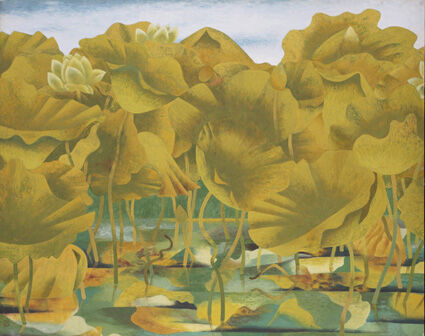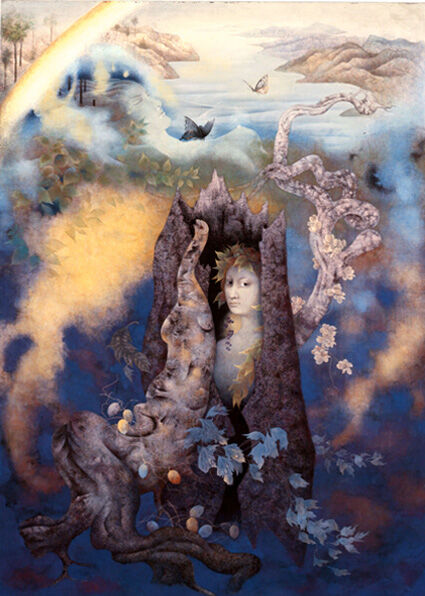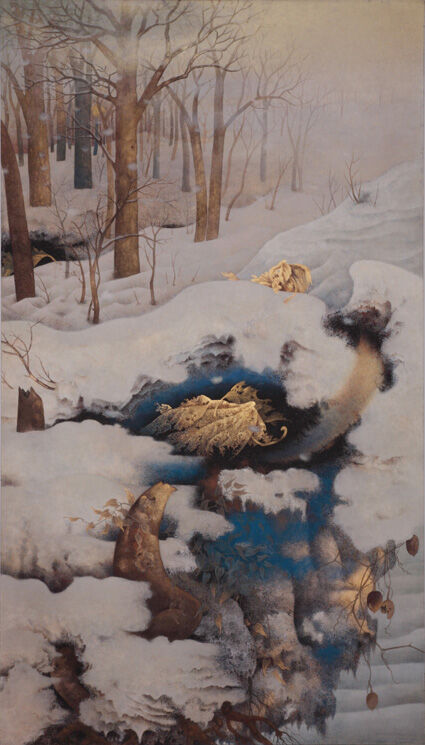KUDO Kojin(1915-2011)
KUDO Kojin was born in 1915 in Momota Village, Nakatsugaru District (now Hirosaki City), in Aomori Prefecture. His boyhood was spent immersed in literature and playing in the world of his imagination while gazing at small plants and creatures, and spots on the wall.
Although he helped on his family’s farm after graduating from higher elementary school, his aspiration to become a painter grew. He moved to Tokyo in 1934 and attended the Kawabata Painting School while working. In addition to the painting school, he acquired basic techniques such as outline sketching for yuzen dyeing. KUDO also and joined the painter FUKUDA Toyoshiro’s study group, where he learned from senior artists pursuing new forms of expression in Japanese painting. KUDO’s works were accepted to the exhibitions of the Japanese Painting Institute (Nihonga-in) and the New Artists’ Society (Shinbijutsujin Kyokai). However, as Japan headed for war, he was drafted into military service and put his painting career on hold. When the war ended, he was demobilized and resumed creating art while farming in his hometown, even though his prewar works had become lost. At FUKUDA’s invitation, KUDO began submitting works to the exhibition of the Sozo Bijutsu (Creative Art) association, which sought to establish new styles of Japanese painting, and got accepted with “Hasu(Lotuses)” in 1950. In the following year, he received the New Artist award at the exhibition of the Shinseisaku Society, with which Sozo Bijutsu association joined up. His two award-winning paintings were inspired by the works of the fifteenth- and sixteenth-century Netherlandish painter Hieronymus Bosch, who blended realism with imagination. KUDO also admitted to being fascinated by the mystical poems and images of the eighteenth-century English painter William Blake since the prewar period. He continued to produce art influenced by the work of his contemporaries as well as these artists from distant eras and places. Through the early 1960s, he created vivid, distinctive works that depicted subjects from nature but in which elements such as trees, birds, and dead leaves took on a surreal presence.
He held a successful solo exhibition in Tokyo in 1961 and moved to Hiratsuka in Kanagawa Prefecture in the following year. In 1964, he was recommended for membership in the Shinseisaku Society. It was around this time that butterflies and symbolic human figures began to appear alongside withered leaves in his works. As exemplified by “Yume to Kakusei(Dreaming and Awakening),” his colors became richer and his techniques more sophisticated in a refined style that harmonizes two opposing worlds with a unique sense of lyricism. He began instructing younger artists at Tokyo University of the Arts in 1971 and joined a university team investigating early Italian Renaissance murals. In 1974, he established the Sogakai Association of Japanese Painting with other artists belonging to the Japanese painting section of the Shinseisaku Society. From the following year to 1976, he worked on a four-part series based on the four seasons, starting with the long, dark winter of snow country, waiting for spring. The series was the culmination of KUDO’s ethos fostered amid the natural environment of his native Tsugaru. This ethos was at the root of KUDO’s art; as KUDO himself stated, a painter needs to have a deep internal darkness and to release the images born from that darkness into the light.
Nicknaming his own studio “Kagukyo(The Snail’s House)” in a reference to the small creature that makes steady progress despite its slow pace and never moves backward, KUDO’s motivation to create art remained unwaning throughout his nearly 80-year career as a painter.
He died in 2011, just a day before his ninety-sixth birthday. His works can be found in the collections of numerous museums, including the Aomori Museum of Art, the Hirosaki City Museum, the Hiratsuka Museum of Art and British Museum.

《Hasu(Lotuses)》
1950
color on paper
97.0×130.3 cm

《Yume to Kakusei(Dreaming and Awakening)》
1971
color on paper
195.0×135.0 cm

《Kyusoku - Fuyu(Rest - winter)》
1975
color on paper
210.0×120.0 cm

